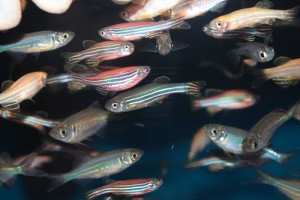KU Leuven Scientist Makes Discovery on Neurodegenerative Process with Zebrafish Molecular Brain Model
Written by |

 Scientists from the VIB Center for the Biology of Disease, KU Leuven identified the molecules responsible for the neurodegenerative process in the human brain by analyzing the nerve tissue of zebrafish embryos, a study that is expected to advance knowledge about the regulation of stem cells and further insights into Alzheimer’s disease.
Scientists from the VIB Center for the Biology of Disease, KU Leuven identified the molecules responsible for the neurodegenerative process in the human brain by analyzing the nerve tissue of zebrafish embryos, a study that is expected to advance knowledge about the regulation of stem cells and further insights into Alzheimer’s disease.
The lead investigator, Evgenia Salta, studied a zebrafish molecular brain model and was able to demonstrate a previously unknown regulatory process for the development of nerve cells. The Notch signaling pathway is the route that controls the maturation of stem cells during embryonic development. Salta examined the expression of genes that create the foundation of the Notch signaling pathway, which is partially controlled by microRNAs (miRNAs).
“The human brain contains stem cells, which are cells that have not matured into nerve cells yet, but do have the potential to do this,” explained Salta. “We specifically studied how miRNA-132 regulates the Notch signaling pathway in stem cells.”
While stem cells play an important role in the development of the brain, the miRNA-132 work as regulators of the adult human brain plasticity. The adult human brain endues stem cells, however, these are limited and when afflicted by a disease of the nervous system that causes death of nerve cells, as Alzheimer’s, the miRNA-132 activity is reduced.
“We wanted to study the effect of the reduction in miRNA-132 in the nervous system. Zebrafish are an ideal model for this, because we can easily reduce levels of this miRNA in them. The development of stem cells is impaired in these altered fish. We mapped the molecules that play a role in this process,” the scientist said.
[adrotate group=”3″]
Therefore, Salta was able to simulate the activity of an Alzheimer’s patient’s brain, in which the miRNA-132 concentration is also reduced.”To our surprise, the reduced activity of miRNA-132 in the zebrafish blocks the further ripening of stem cells into nerve cells. This new knowledge about the molecular signaling pathway that underlies this process gives us an insight into the exact blocking mechanism,” she explained.
“Thanks to this work in zebrafish, we can now examine in detail what exactly goes wrong in the brains of patients with Alzheimer’s disease,” added Salta, who is now planning on conducting a follow-up study in mice, as well as in deceased patients, to confirm the results of her research.
Stem cells also exist in zebrafish and, with 3 to 5 cm length, its eggs are fertilized outside the body, being transparent during their first period of life, which made them ideal study models for Salta’s research. Humans and zebrafish share 90 percent of the genetic code, and the species’ genetic material is easily manipulated.





